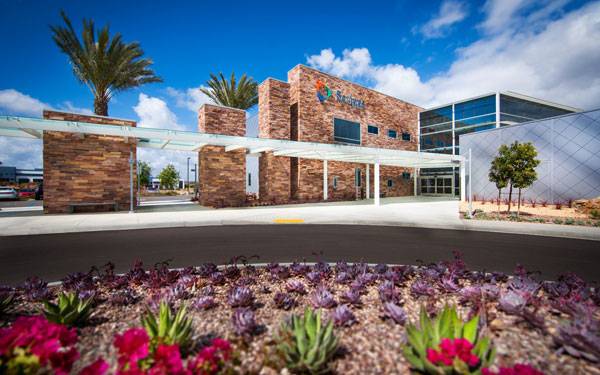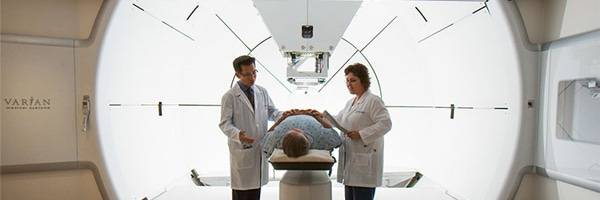 |
| Scripps Proton Therapy Center - San Diego |
 |
| Proton Therapy for Cancer Treatment - Scripps Health |
Proton therapy center files for bankruptcy - The San Diego Union-Tribune
Just three years after opening its doors, San Diego’s only proton therapy center [operated under lease by Scripps Healthcare] is seeking Chapter 11 bankruptcy protection. [Case 17-10477-LSS Doc 1 Filed 03/01/17 California Proton Treatment Center, LLCpetition.pdf] At a hearing in Delaware bankruptcy court scheduled for Friday, owner California Proton Treatment Center will ask a judge to approve a $16 million short-term loan to pay for continued operations while a restructuring effort proceeds. The investment group that owns the $220 million state-of-the-art facility on Summers Ridge Road filed Wednesday under Chapter 11 of the U.S. Bankruptcy Code, stating in court papers that the center “has not operated on a profitable or even a break-even basis.”
“Unfortunately (California Proton Treatment Center’s) projections, which they used to build and finance the center, never lived up to their expectations,” [Scripps CEO] Van Gorder said, adding that the number of prostate cases referred were far fewer than seemed reasonable during planning and construction.
“It has been able to cover it’s operating expenses. What it has not been able to pay back is the debt,” Van Gorder said.
There are some big bills to pay. Court filings indicate that proton therapy is a power-hungry enterprise with a $123,000 average monthly utility bill. As part of its bankruptcy filing the center is asking a judge to prevent San Diego Gas and Electric from shutting off the power while restructuring is under way.
Dream of a new weapon in Cancer Battle
| Shannon litz/Nevada Appeal Jeff Bordok talks about Advanced Particle Therapy at The Record-Courier |
A small Minden company, Advanced Particle Therapy APT, has found its
niche in the ever-advancing battle against cancer, and for the company’s
president, Jeff Bordok, the battle is personal.
“I lost my father to cancer. My wife
lost her father to cancer. It touches everyone, and to be able to
provide a better treatment alternative is very rewarding,” he said.
“When I get around doctors, patients and survivors, I see how important
it is to make this happen.”
The 63-year-old Gardnerville resident,
president and CEO of Advanced Particle Therapy, just returned from San
Diego where his company is breaking ground on the 102,000-square-foot,
$185 million Scripps Proton Therapy Center,
DOTmed.com - Q&A with Jeff Bordok, CEO of Advanced Particle Therapy
Advanced Particle Therapy has been involved with the development and ownership of proton treatment centers for the past eight years. APT provides a fully integrated solution for proton therapy with operations by our clinical partners. Our clinical partners are major health care systems and medical academic institutions. Currently the institutions include Scripps Health and Scripps Clinic Medical Group, the University of Maryland, Emory Healthcare/ Emory University and the University of Texas Southwestern Medical Center.
The Scripps Proton Therapy Center is a freestanding center owned and developed by California Proton Treatment Center, LLC a special purpose entity formed for the project by Advanced Particle Therapy. The 100,000 sq. foot center has five treatment rooms (three rotational gantries and two fixed beam rooms). The Center features state-of-the-art technology including the Varian ProBeam proton therapy system [ProBeam Proton Therapy System | Varian Medical Systems] and diagnostic equipment including PET-CT, CT and MRI.
Another Domino Falls?
Kelcy Warren's Investment, California Cancer Treatment Center, Files for Chapter 11California Proton Treatment Center LLC, the developer of the Scripps Proton Therapy Center in San Diego, filed for Chapter 11 on Wednesday, March 1, and intends to sell the cancer treatment facility.
The Scripps facility is the third of its kind to enter Chapter 11 since 2015; all of them have received backing from Advanced Particle Therapy LLC (APT). The debtor is due in court before Judge Laurie Selber Silverstein of the U.S. Bankruptcy Court for the District of Delaware in Wilmington on Friday on its request to access a $32 million debtor-in-possession loan.
 |
| Kelcy Warren - Wikipedia |
- - -
JPMorgan, ORIX and Varian are owed a combined $180.74 million on three classes of notes. The DIP rolls up $16 million of that prepetition indebtedness and also offers $16 million in new money. It carries a $560,000 upfront fee and an interest rate of LIBOR plus 9% and will mature upon consummation of a sale.
The California Proton Treatment Center's largest unsecured creditors include MMBC Proton Inc. ($275,000), San Diego Gas & Electric ($194,600), SCG Capital Corp. ($95,000), GE Healthcare ($48,125) and Varian ($33,153). It listed assets and liabilities between $100 million and $500 million in its petition.
Proton High Costs versus Unsold Benefits
In proton therapy, a beam that contains the positively charged particle is fired at cancerous tissue. Studies on the effectiveness of proton therapy relative to other forms of radiation treatment have been inconclusive.Proton therapy: Less invasive, less available? | NJ.com
Delivering the benefit -- less entrance dose than radiation and no exit dose -- however, is also the inherent difficulty associated with proton therapy.
"Because protons are heavier, the process needed to accelerate them to 70 percent of the speed of light is a true physics and engineering challenge," said Khan.
At centers like ProCure, where a massive cyclotron machine accelerates protons to the speed required for their use and delivers them through a beam transport system to each of a handful of patient rooms, Khan said that traditional proton therapy machines can cost $150-250 million. The cost has limited their presence to fewer than two dozen sites nationwide, of which just two -- ProCure and the Laurie Proton Therapy Center at Robert Wood Johnson University Hospital -- reside in New Jersey.
"Until 2006, there were only two proton therapy centers in the U.S. (at Loma Linda University Medical Center in California and at Massachusetts General Hospital); 16-20 more have been built in the last decade for a total of 22-23 proton therapy operating centers in the U.S. today," said Dr. Sameer Keole, proton beam therapy medical director at the Mayo Clinic in Scottsdale, Ariz.
"It's prohibitively expensive for the vast majority of medical centers," noted Keole, who added that as a result, proton therapy currently accounts for less than 1 percent of all of the radiation given in the U.S., a number that's expected to double to just 2 percent by 2023.
"It's been particularly effective in treating prostate cancer and could truly make a difference in cases where radiation and chemotherapy are combined because that can be a toxic treatment, but we have a long way to go before we have enough proton supply to treat all of the eligible patients," said Keole, who is also vice chair of the Government Relations Council for the American Society for Radiation Oncology in Arlington, Va.
Alongside investor-financed centers like ProCure, RWJ is hoping to change that dynamic by offering its own state-of-the-art approach to proton therapy in the form of a more compact cyclotron dramatically reduced footprint -- not to mention a dramatically reduced price tag of just $20 million per machine.
Insurance Hurdles for patients
A big impediment for patients, so far, is that not all insurance companies cover proton therapy; some insurance carriers cover proton therapy for approved applications and grant case-by-case approvals based on medical necessity, Robert Wood Johnson's Khan said. He also said he expects to see less-expensive machines like RWJ's proliferate nationwide along with more sustained efforts to study proton therapy versus conventional radiation in clinical trials.Dr. Otis W. Brawley, chief medical officer for the American Cancer Society, said currently coverage for proton therapy varies among insurance carriers. He said coverage decisions are made on a case-by-case basis as medical need justifies it, citing an example of a patient who with prostate cancer who also suffers from Crohn's disease, a condition which might be exacerbated by conventional X-ray radiation.
Owners of Scripps Proton Therapy Center File for Bankruptcy | San Diego Business Journal
Scripps President and CEO Chris Van Gorder said he did not know about plans for the bankruptcy filing until after it happened, but that the health care system had been anticipating such a move for months because of CPTC’s “enormous amount of debt.”
“Scripps knew that this was a high-risk venture from the very beginning,” he said.
Van Gorder added that shortly before the center’s opening in 2014, commercial insurers shifted away from proton therapy toward a form of conventional treatment [IMRT] that uses a narrow beam of radiation. He said Scripps continues to believe proton therapy is the more effective therapy, largely because protons stop at the target site rather than continuing through a patient’s body.
He said Scripps has no financial exposure to CPTC’s bankruptcy, and that the health system only leases and operates it.
Lately, patient volume at the center has averaged 70 at any given time, even as more than 200 calls per month come in from people interested in receiving treatment there, Van Gorder said, adding that the facility needs a steady flow of 130 to 140 patients to thrive.
References:
- Advanced Particle Therapy, LLC - List of CEOs, founders and company directors
- Loan and Security Agreement
- Is this the first Domino to Fall? | Student Doctor Network
- Case 17-10477-LSS Doc 1 Filed 03/01/17 California Proton Treatment Center, LLCpetition.pdf
- Kelcy Warren's Investment, California Cancer Treatment Center, Files for Chapter 11
- DOTmed.com - Q&A with Jeff Bordok, CEO of Advanced Particle Therapy
- Haskell Selected to Complete Design/Build for Scripps Proton Therapy Center in San Diego
- Minden company spearheads proton therapy center | NevadaAppeal.com
- Advanced Particle Therapy LLC | Business Litigation & Securities Arbitration Lawyers
- $200M Atlanta Cancer Center Creditors Try To Force Ch. 11 - Law360
- Owners of Scripps Proton Therapy Center File for Bankruptcy | San Diego Business Journal
- New Delaware Chapter 11 Filing - California Proton Treatment Center, LLC (Case No. 17-10477 (LSS)) | Bankruptcy & Restructuring Law
- Owner of Scripps Proton Therapy Center files for bankruptcy
- Mevion S250 Superconducting Synchrocyclotron Delivered to Robert Wood Johnson University Hospital | Imaging Technology News
- Proton Therapy Centers Location Map and Listings
No comments:
Post a Comment